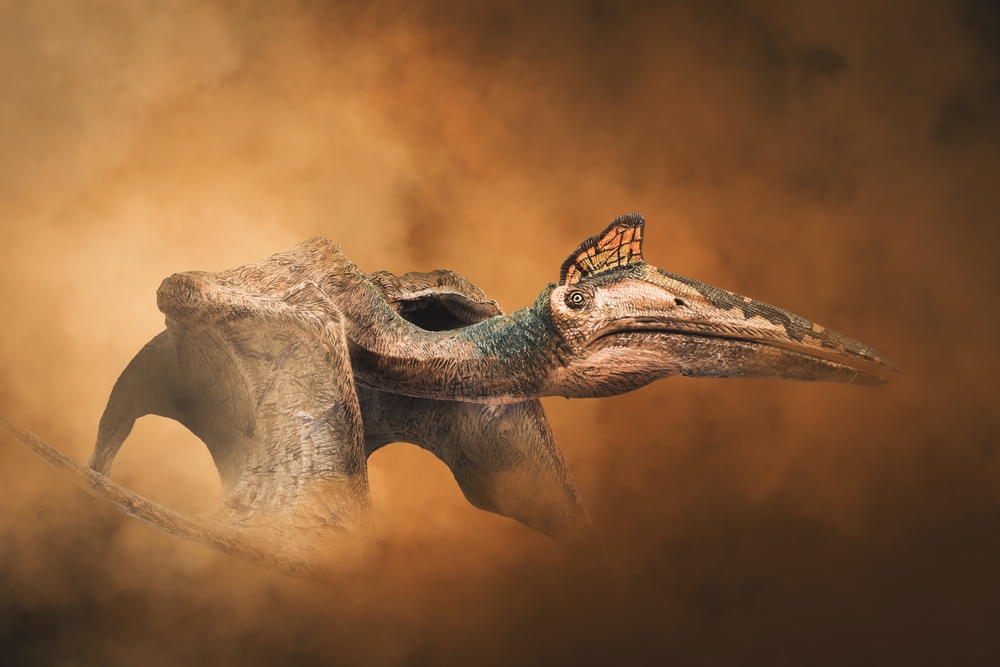5 Of The Most Interesting Flying Dinosaurs
Posted on Categories Discover Magazine

Pterosaurs are often referenced as “flying dinosaurs,” though they’re just flying reptiles — cousins to dinosaurs. From the late Triassic period to the end of the Cretaceous period, Petrosaurs dominated the sky. They could be as large as fighter jets and as small as toy planes. Here are five of the most fascinating flying dinosaurs.
1. Pterodactylus
(Credit: Elenarts/Shutterstock)
Pterodactylus was the first pterosaur to be recognized as a flying reptile. First described in 1784 by Italian Naturalist Cosimo Collini — based on unearthed fossils from Bavaria — it had an unusual straight jaw containing approximately 90 teeth. At first, researchers misidentified it as a marine animal that used its large arms as flippers to move through the water. It wasn’t until the mid-1800s that it was fully recognized as a flying animal.
Pterodactylus is by far the most well-known of all the pterosaurs, leading to the name “Pterodactyl” becoming synonymous with all pterosaurs, even though it is its own species.
They most likely bred each season and continued to grow throughout their lives, similar to crocodiles. Unlike crocodiles, Pterodactylus is believed to have been warm-blooded, although that is a more recent theory.
Read More: Scientists Can Now Distinguish Between Warm- and Cold-Blooded Dinosaurs
2. Quetzalcoatlus
(Credit: kamomeen/Shutterstock)
In 1971, a geology graduate student named Douglas Lawson was doing fieldwork in Big Bend National Park when he discovered fossils that became the first known Quetzalcoatlus. With a 33 to 38-foot wingspan and a weight of 440 to 550 pounds, this animal is believed to have been the largest flying creature ever to inhabit the Earth.
It was long believed that Quetzalcoatlus flew similarly to eagles and condors, using updrafts to fly. But further research has led scientists to conclude that they were, in fact, short-range flyers who spent much of their time on land hunting small reptiles, insects, rodents and even small dinosaurs.
Read More: How Big Was Quetzalcoatlus and Other Giant Pterosaurs?
3. Dimorphodon
(Credit:Michael Rosskothen/Shutterstock)
In 1828, on the coast of southern England, fossil hunter Mary Anning discovered the first known remains of a Dimorphodon. A little over three feet long with a wingspan of four and a half feet, Dimorphodon had a large, bulky head that was lightened by large openings in its skull.
While incapable of long-distance flying, they would have engaged in short, rapid flights. This would be similar to the flying habits of modern-day woodpeckers. They had large, pointy teeth in the front part of their jaws and smaller teeth in the back. They used a “snap and hold” technique for feeding — using their quickly closing but relatively weak jaw to consume insects and small vertebrates.
Read More: How Do Scientists Reconstruct What Dinosaurs Looked Like?
4. Rhamphorhynchus
(Credit:Michael Rosskothen/Shutterstock)
The size of a modern-day seagull, Rhamphorynchus had a body covered with short hair-like fibers — as did other pterosaurs. These flying reptiles had short necks and a long, bony tail that comprised half its length. With their sharp teeth, they grabbed food by putting their beak into the water and snatching up prey.
They would then throw the food from its teeth to a pouch in its throat. The throat pouch has been preserved in some fossils, and scientists believe it was used for food storage. The most notable Rhambhorynchus fossils have been unearthed from the Solnhofen quarry in Bavaria. Not only have bones been preserved, but researchers also found wing and tail impressions.
Read More: Massive Flying Pterosaurs Evolved With a Little Help From Mom and Dad
5. Ornithocheirus
(Credit:Ozja/Shutterstock)
One feature distinguishing Ornithocheirus from other pterosaurs was a bony convex crest, called a “keel,” on the end of its snout. This was probably used to attract mates, crack open crustacean shells or threaten fellow pterosaurs hunting the same prey. Originally believed to be much larger, it is now estimated that the Orinthocheirus wingspan was about 15 to 20 feet, and their weight ranged from 50 to 100 pounds.
With a relatively narrow jaw and sharp, needle-like teeth, they flew above the water to hunt, using their long beak to skim the water for prey. As piscivores, they hunted and primarily ate fish, although they would have grazed on plants and grass for additional sustenance.
Read More: Do We Still Have Any Species Today That Are Descendants of Dinosaurs?